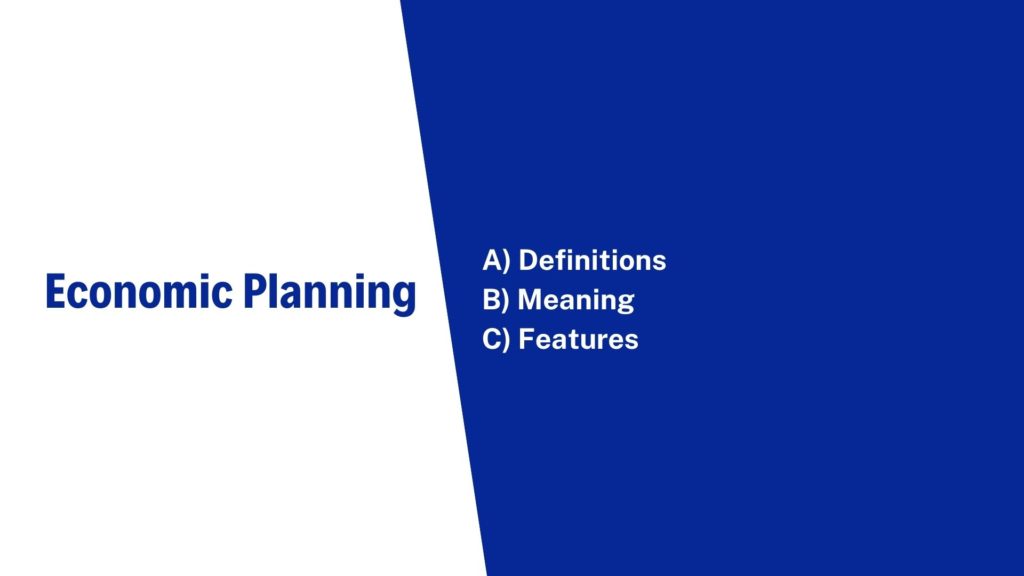Definition of Economic Planning (Meaning and Objectives) | Free Economic Blogs
Table of Contents
Definition of Economic Planning

Meaning and Definition of Economic Planning
Economic planning is a time-bound programme to achieve certain objectives with the help of available resources by the planning authority.
According to Dr. H. D. Dickinson: “”Economic planning is the making of major economic decisions such as what and how much to be produced how, when and where it is to be produced, to whom it is to be allocated by the conscious decision of the determinate authority, on the basis of a comprehensive survey of the economy as a whole”.
According to Prof. Seligman: “Planning is a conscious and deliberate choice of economic priorities by some public authority.”
- Microeconomic Definition | Historical Review of Microeconomics
- Scope Or Nature of Microeconomics
- Features of Microeconomics
- Importance of Microeconomics
Objectives of Economic Planning
Economic planning has the following objectives
1) Economic Growth
The objective of achieving economic growth implies that the real national income and per capita income must grow every year at a targeted rate. Real national income is the measure of national income at a given year’s price or at a constant price. Real per capita income is the average income of individuals in the economy. It is argued that in order to achieve a higher standard of living for each individual /household and the society as a whole, both per capita income and national income must grow in real terms. Since income represents purchasing power, an increase in income will enhance the purchasing power of people and the country
2) Increase in employment
Employment refers to the engagement of the labour force in gainful economic activity such as the production of goods and services. Income is generated through the production process where the production process involves the employment of factors of production provided by the households. You know that factors of production include land, labour, capital and organization/entrepreneurship. These factors are owned by the households of the country.
You know that the population of the country supplies labour force who are in the age group of 15 to 59 years. Every year due to increase in population the number of people in the labour force is also increasing. Most of them are also educated. If there is not enough scope to get employment then they will remain unemployed and unutilized. In fact, the unemployment situation in India is very bad. Besides causing an increase in consumption without a corresponding increase in production, unemployment also is a cause of various social problems such as poverty and crime etc. So planners of the Indian economy put creation of employment as a major objective of five-year plans.
3) Reduction in inequality of income
India is a country with diverse economic standards of its population. This means that in terms of income level, India lacks uniformity. A large section of India’s population belongs to lower-income groups and is termed as poor whereas a few are very rich with a very high level of income. Income disparity is a major concern of the social angle, women are the worst affected in terms of income standard irrespective of their caste or religion.
India is badly affected due to this inequality. The poor people are not able to support the market due to lack of purchasing power where too much purchasing power with the rich has caused wasteful consumption to increase. Most of the social evils are created due to inequality. Hence, our planners aimed at reducing the inequality in income distribution through planning.
4) Reduction in poverty
Another major objective of planning in India is “reduction In poverty”. At the time of independence, more than fifty per cent of India’s population was poor. By the year 2014, nearly 27 to 28 per cent of India’s population is under poverty as per governments estimates. You will come to know about the manner in which poverty is estimated in India in the lesson on poverty and employment. For the time being, let us confine our notion of poverty to the situation wherein an individual is unable to satisfy his/her basic minimum needs of life.
There are lot of people in the country who are not even getting a square meal a day. Lack of employment is a major cause of poverty. It is exaggerated by unequal distribution of national wealth and income. Poverty is termed as a curse on human dignity and it has seriously tarnished the image of India in the world. Developed countries do not count India seriously due to its inability to remove poverty. It is proper planning to remove poverty completely from the country.
5) Modernization of the economy
India has been a country of continuous exploitation by foreign powers such as the Mughals who ruled for more than two hundred years and the British who also ruled the country for another two hundred years. The British in particular, left the country in dine poverty and underdevelopment when they handed over power to the Indian government in 1947. Because of historical reasons Indian economy could not rise from its traditional level of functioning. It remained an agrarian economy and industrially backward. There was no development in now technology and technological upgradation. Lack of modern technology is a major reason for Indian economy to suffer from low productivity in agriculture and lack of industrial development.
At the time of independence and for many more years after that, the major contributor to India’s GDP because of underdeveloped industrial and service sector. Combined with his lack of better education and skill development of the population, the occupational structure has also remained biased towards agriculture. Hence, to reverse such trend it is necessary to change the structure of GDP of India by improving the quality of human resources and developing industries and service sector. This can be done by modernization of the economy.
6) Social justice and equality.
Indian planning also aimed at achieving a socialistic pattern of society. It can be achieved by ensuring its population social justice and equity. In fact, all the objectives said above are necessary to achieve social justice. But the sufficient condition for sustaining social justice and equitable distribution of income is to introduce reforms in various sectors by changing the age-old systems which have perpetuated poverty and inequality and obstructed the development of industrial and service sector or caused low productivity in agriculture. So the planners thought to introduce reforms in agriculture and economic policy so that they facilitate growth and equitable distribution of the benefits of development.


